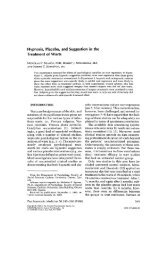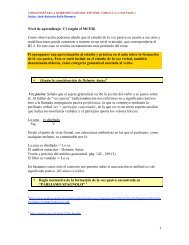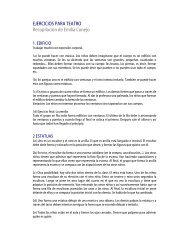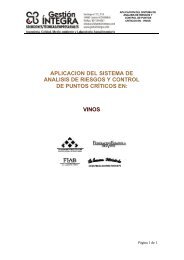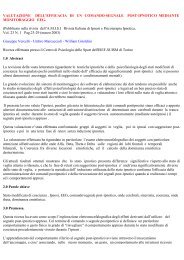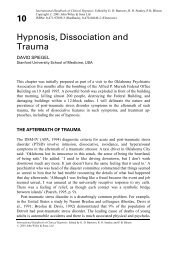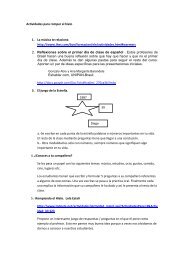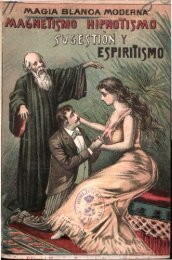Hypnosis and the Law: Examining the Stereotypes
Hypnosis and the Law: Examining the Stereotypes
Hypnosis and the Law: Examining the Stereotypes
Create successful ePaper yourself
Turn your PDF publications into a flip-book with our unique Google optimized e-Paper software.
1280 CRIMINAL JUSTICE AND BEHAVIOR<br />
One of <strong>the</strong> most famous cases of supposed coercion is that of Palle Hardrup in 1951<br />
(Reiter, 1958). According to <strong>the</strong> st<strong>and</strong>ard account, Hardrup committed two bank robberies<br />
in Copenhagen, during which he shot dead two bank tellers. At <strong>the</strong> trial, evidence was presented<br />
to <strong>the</strong> effect that he had been under <strong>the</strong> influence of hypnosis at <strong>the</strong> time <strong>and</strong> was,<br />
<strong>the</strong>refore, not responsible for his actions. He was subsequently released, whereas his<br />
hypnotist, who had been a close friend, was given a life sentence. However, Hardrup was<br />
subsequently committed to an institution for <strong>the</strong> insane, where he changed his story, stating<br />
that <strong>the</strong> hypnotist had never hypnotized him. Summarizing cases—including <strong>the</strong> Hardrup<br />
case—Barber (1969) made <strong>the</strong> following points:<br />
Two facts st<strong>and</strong> out: a) prior to <strong>the</strong> supposed introduction of hypnosis a close relationship had<br />
existed between <strong>the</strong> subject <strong>and</strong> <strong>the</strong> hypnotist; b) <strong>the</strong> relationship extended over a lengthy<br />
period of time, <strong>and</strong> involved strong emotional ties. ... If hypnosis played a role in <strong>the</strong>se<br />
cases, this role may have consisted in providing <strong>the</strong> subject with a rationale for justifying his<br />
behavior to himself <strong>and</strong> o<strong>the</strong>rs. (p. 202)<br />
Ano<strong>the</strong>r typical case is that in <strong>the</strong> United Kingdom of R. v. Mohammed in 1989 (cited in<br />
Mottahedin, 1992). In this, two experts gave evidence that <strong>the</strong> female defendant had been<br />
hypnotized <strong>and</strong> brainwashed by her husb<strong>and</strong> into committing <strong>the</strong> crime of attempted murder.<br />
However, <strong>the</strong> same kinds of factors present in <strong>the</strong> Hardrup case also applied here; that<br />
is, prior to <strong>the</strong> offense, <strong>the</strong>re was a close manipulative relationship between hypnotist <strong>and</strong><br />
participant that had existed over an extended period of time.<br />
Ra<strong>the</strong>r more common are claims that victims have been reduced by hypnosis to helpless<br />
hypnotic automata <strong>and</strong> subjected to sexual assault without <strong>the</strong>ir consent <strong>and</strong>/or knowledge;<br />
some of <strong>the</strong>se appear to have received more sympa<strong>the</strong>tic consideration by <strong>the</strong> courts<br />
(Wagstaff, 1999a). The obvious difficulty with real-life situations, however, is that it is<br />
impossible to distinguish <strong>the</strong> effects of hypnosis from o<strong>the</strong>r causal factors that may have<br />
influenced <strong>the</strong> behaviors in question. For example, in addition to personal relationships <strong>and</strong><br />
o<strong>the</strong>r motivational factors that may have existed prior to any sessions of hypnosis, <strong>the</strong> hypnotic<br />
situation itself involves strong social dem<strong>and</strong>s. By consenting to engage in hypnosis,<br />
<strong>the</strong> participant places himself or herself in a social situation in which he or she has tacitly<br />
agreed to trust <strong>the</strong> hypnotist <strong>and</strong> do what is instructed or suggested (Orne, 1962, 1970;<br />
Wagstaff, 1981). This is especially so when <strong>the</strong> context is defined as <strong>the</strong>rapeutic; in such<br />
situations, as in counseling <strong>and</strong> psycho<strong>the</strong>rapy generally, clients can develop a very powerful<br />
emotional bond with <strong>the</strong>ir <strong>the</strong>rapists. Such situations are ripe for abuse, especially when<br />
<strong>the</strong> abuse is initially disguised by relaxation techniques; for example, in some cases,<br />
offenders have engaged in sexual assault having introduced <strong>the</strong> inappropriate physical contact<br />
as a relaxing hypno<strong>the</strong>rapeutic massage.<br />
Because of <strong>the</strong> difficulties involved in controlling for <strong>the</strong>se factors, researchers have<br />
turned to experimental methods to try to test <strong>the</strong> coercive powers of hypnosis.<br />
HYPNOTIC COERCION IN THE LABORATORY<br />
A few early reports claimed that hypnotized persons can be made to perform acts that are<br />
immoral or harmful to ei<strong>the</strong>r <strong>the</strong>mselves or o<strong>the</strong>rs; such acts have included indecent exposure,<br />
picking up a dangerous snake, throwing acid at <strong>the</strong> experimenter, minor <strong>the</strong>fts, <strong>and</strong> verbal<br />
Downloaded from<br />
http://cjb.sagepub.com at SAGE Publications on October 31, 2008




